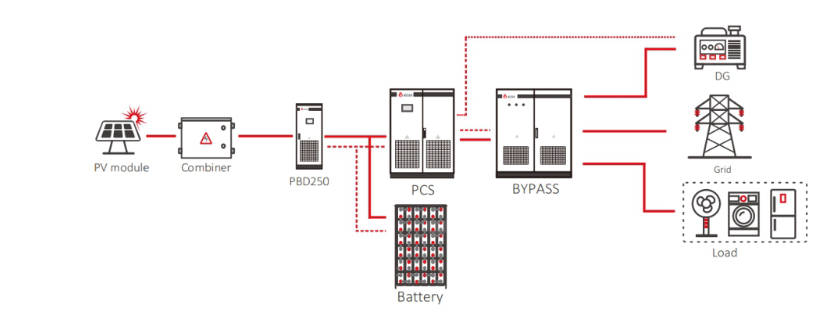Blog
Energy storage converter, also known as bidirectional energy storage inverter, English name PCS (Power Conversion System), is used in AC coupled energy storage systems such as grid-connected energy storage and microgrid energy storage. It connects the battery pack and the power grid (or load) and is a device that realizes bidirectional conversion of electric energy. It can convert the DC power of the battery into AC power and transmit it to the power grid or use it for AC load; it can also rectify the AC power of the power grid into DC power to charge the battery.
Energy storage converter (PCS) consists of power, control, protection, monitoring and other hardware and software. It is divided into single-phase and three-phase. Single-phase PCS usually consists of a bidirectional DC-DC buck-boost device and a DC/AC AC-DC conversion device. The DC end is usually 48Vdc and the AC end is 220Vac. Three-phase is divided into two types. The low-power three-phase PCS consists of a bidirectional DC-DC buck-boost device and a DC/AC AC-DC conversion two-stage device, and the high-power three-phase PCS consists of a DC/AC AC-DC conversion one-stage device. Energy storage inverters are divided into three types: high-frequency isolation, power frequency isolation and non-isolation. Single-phase and low-power three-phase PCS below 20kW generally use high-frequency isolation, 50kW to 250kW generally use power frequency isolation, and 500kW and above generally use non-isolation.

Important technical parameters of energy storage inverters: Due to different application scenarios, the functions and technical parameters of energy storage inverters vary greatly. When selecting, attention should be paid to system voltage, power factor, peak power, conversion efficiency, switching time, etc. The selection of these parameters has a great impact on the function of the energy storage system.
System voltage
is the voltage of the battery pack and the input voltage of the energy storage inverter. Energy storage inverters with different technologies have a large difference in system voltage. The single-phase two-stage energy storage inverter is about 50V, and the three-phase two-stage energy storage inverter is between 150V-550V. The three-phase energy storage inverter with power frequency isolation transformer is between 500V-800V, and the three-phase energy storage inverter without power frequency isolation transformer is between 600V-900V.
Power factor
When the energy storage inverter is operating normally, the power factor should be greater than 0.99. When the system participates in power factor regulation, the power factor range should be as wide as possible.
Switching time
There are two switching times for energy storage inverters. One is charging and discharging switching. Large energy storage inverters should be able to switch operating states quickly. It is usually required that the switching time is no more than 200ms between the 90% rated power grid-connected charging state and the 90% rated power grid-connected discharging state. The second is applied to the switching between the grid-connected mode and the off-grid mode. The switching time is no more than 100ms.
Energy storage inverters mainly have two working modes: grid-connected and off-grid. Grid-connected mode realizes bidirectional energy conversion between battery packs and power grids. It has the characteristics of grid-connected inverters, such as anti-islanding, automatic tracking of grid voltage phase and frequency, low voltage ride-through, etc. According to the requirements of grid dispatch or local control, PCS converts the AC power of the grid into DC power during the low load period of the grid to charge the battery pack, and has the function of battery charge and discharge management; during the peak load period of the grid, it converts the DC power of the battery pack into AC power and feeds it back to the public grid; when the power quality is poor, it feeds or absorbs active power to the grid and provides reactive power compensation. Off-grid mode, also known as isolated grid operation, means that the energy conversion system (PCS) can be disconnected from the main grid according to actual needs and meet the set requirements, and provide AC power that meets the power quality requirements of the grid to some local loads.
Summary
In a microgrid system composed of multiple energy sources, the energy storage inverter is the most core equipment, because renewable energy such as photovoltaics and wind power is volatile, and the load is also volatile. The fuel generator can only generate electricity but cannot absorb electricity. If there are only photovoltaic, wind and fuel generators in the system, the system operation may be unbalanced. When the power of renewable energy is greater than the load power, the system may fail. Therefore, it is difficult for photovoltaic grid-connected inverters to be connected to the fuel generators. The energy storage inverter can absorb energy, emit energy, and react quickly, playing a balancing role in the system.